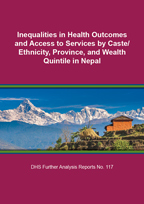There is no printed copy available to order.
Abstract:
This study examines the differentials and trends in health outcomes and service utilization by caste/ethnicity, provinces, and wealth quintiles, and discusses gaps in the health indicators. The 2011 and 2016 Nepal DHS data were used to examine trends in the key indicators and to determine if changes over the two survey periods were statistically significant.
There are variations in the decline of fertility among different caste/ethnicity groups in Nepal. The Hill Brahmin, Hill Janajati, Terai Janajati, Terai/Madhesi Brahmin/Chhetri, and Newars have reached the replacement level fertility, whereas the Terai/Madhesi Dalits and Muslims continue to have much higher fertility than the national average. Increased use of modern contraceptives over the past 5 years is statistically significant only among Janajatis, while its decline is statistically significant among three caste/ethnicity groups – Newars, Terai/Madhesi Brahmin/Chhetri, and Hill Brahmins. The use of modern contraceptives has increased significantly in Province 1 but has decreased significantly in Province 3. By household wealth status, the increase is significant in the lowest and the second quintiles, while the decrease is significant in the fourth and the highest quintiles. The lowest percentage of having four or more antenatal care visits was observed among the Terai/Madhesi Dalit caste, in Province 6 (Karnali Province), and in the lowest wealth quintile. A similar pattern was observed with delivery assisted by a skilled birth attendant.
There were substantial differences in full immunization coverage of children age 6-59 months and childhood mortality by caste/ethnicity, provinces, and household wealth. The decline in full immunization coverage is significant among most of the caste/ethnicity groups and in all provinces except Provinces 3, 4, and 6. Childhood mortality is two times higher among Terai/Madhesi Dalits than the national average. Provinces 2, 5, 6, and 7, and the poorest households have the highest childhood mortality. Stunting is the highest among children from the Terai/Madhesi Dalits and the Terai/Madhesi Other caste/ethnicity group, in Province 6 (Karnali Province), and among households in the lowest wealth quintile. Anemia among children has increased significantly among Janajatis and in Provinces 1 and 2. Anemia in women has increased in almost all caste/ethnicity groups, provinces, and wealth quintiles. Hypertension in Nepal is more prevalent among the Newar caste group, in the wealthiest quintile, and in Province 4 (Gandaki Province).
The analysis by caste/ethnicity shows that the Terai/Madhesi Other and Terai/Madhesi Dalit consistently showed poor performance in most indicators. Health outcomes and service utilization are generally low in Province 2 and among women from the poorest households. The findings suggest that urgent efforts with explicit provincial strategies are needed to minimize the gap in health outcomes and service utilization of the Terai Madhesi caste groups and the poorest of the population.
 Inequalities in Health Outcomes and Access to Services by Caste/Ethnicity, Province, and Wealth Quintile in Nepal (PDF, 1464K)
Inequalities in Health Outcomes and Access to Services by Caste/Ethnicity, Province, and Wealth Quintile in Nepal (PDF, 1464K)
